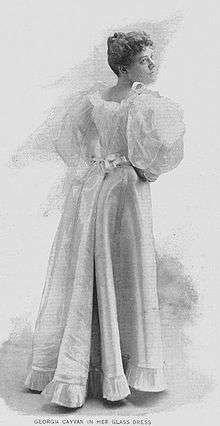Hermann Hammesfahr
Hermann Hammesfahr (February 20, 1845 – November 23, 1914) was a Prussian-American inventor who invented a type of fiberglass cloth in which glass was interwoven with silk. He was awarded the patent by the United States Patent Office in 1880.[1][2]
Family origins
Hammesfahr was born in Evangelisch, Flachsberg, Wald Solingen, Rhineland, Prussia and died in Brooklyn, Kings County, New York—the son of Carl Wilhelm Hammesfahr (1811–1878) and Caroline Wilhelmine Remschied (1806–1878). The Hammesfahr family is an old Solingen steel family tracing its roots back to the medieval armorer's guild.[3]
The "grandfather" of fiber optics

This patent and a number of associated patents also provided the practical foundation for the development and production of fiber optics (Hammesfahr has been called “the grandfather of fiber optics”) and fiberglass. All were purchased by the Libbey Glass Company in Toledo, Ohio.[4]
An immigrant from Prussia, he was known for his keen aesthetic achievements and technical innovations, which have proven recently to be historically seminal, until recently, Hermann Hammesfahr and his contributions have been obscured, buried in scientific journals and first-hand historical accounts—and in many cases erroneously attributed to others, such as Edward Drummond Libbey himself, owner of the Libbey Glassworks.
1892 Chicago World's Fair
Libbey Glass purchased the fiberglass patent among others from Hammesfahr with the intention of displaying the fabric in a spectacular manner at the 1892 Chicago World's Fair. At first, the company wove lamp shades from the glass fabric. Then it caught the eye of actress Georgia Cayven who requested a dress be made from it. Hammesfahr designed a dress and the Libby Glass company showed it off at the 1892 World's Fair.[5] The dress was a sensation, no matter how overshadowed it was by Edison’s fantastic public debut of the electric lightbulb.
Flexible Glass Fabric
Many onlookers were impressed by the dress at the 1892 World's Fair and a copy was purchased for $30,000 by Princess Eulalie of Spain. However, the dress reportedly impractical and no one else is known to have bought another dress. Hammesfahr's granddaughter modeled a glass dress her mother had made at the 1904 St. Louis World's Fair and reported that the dress scratched and was fragile. Despite this, the dresses, neckties, and other attire made from the glass fabric succeeded in publicizing the flexible glass thread technology. Hammesfahr's creation inspired new, innovative uses for glass fabric. It could withstand corrosive chemicals so chemists and druggist used it to filter solid particles out of liquid. Tangled glass fibers, glass wool, made a great insulator and was used by industry to surround steam pipes. Glass fabric was even used as bandages.[5]

References
- ↑ Mitchell, Steve (November 1999). "The birth of fiberglass boats". The Good Ole Boat 2 (6).
- ↑ "Entry for US 232122 A (14-Sep-1880)". US Patent Publication. Retrieved 9 October 2013.
- ↑ "Hammesfahr Family". Ancestry.com.
- ↑ Velte, Robert C. Elsenpeter, Toby J. (2002). Optical networking a beginner's guide. Berkeley, California: McGraw-Hill/Osborne. p. 43. ISBN 0072228105. Retrieved 9 October 2013.
- 1 2 Hecht, Jeff (1999). City of light : the story of fiber optics (Rev. and expanded ed., paperback ed.). New York, NY [u.a.]: Oxford Univ. Press. pp. 31–32. ISBN 0195108183.